The IOCCG news bulletins include news from the IOCCG, its sponsoring agencies, and the broader ocean colour community. If you would like to submit an item of interest for the next IOCCG news bulletin, please contact Dr. Raisha Lovindeer, with a cc: to Dr. Venetia Stuart. If you are having trouble receiving email notifications from IOCCG, please see instructions on how to Whitelist “Campaign Monitor” (the IOCCG email marketing platform). Please also add the ioccg.org domain to your safe list (especially important for subscribers with Gmail accounts – also check your SPAM folder). You can also follow IOCCG on Twitter.
IOCCG News
Applications Now Open for 2022 IOCCG Summer Lecture Series
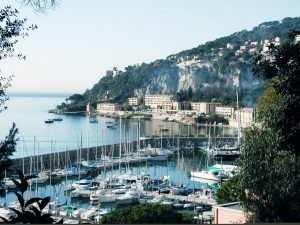 The 2-week long 2022 IOCCG Summer Lecture Series (SLS) is scheduled to take place from 18-29 July 2022. It will be held in Villefranche-sur-Mer, France, at the Laboratoire d’Océanographie de Villefranche (LOV), part of the Institut de la Mer, de Villefranche (IMEV) which hosts the Marine Optics, Remote Sensing, and Biogeochemical Applications group. The lecture series has occurred biennially since 2012, and is a high-level training course dedicated to the fundamentals of ocean optics, bio-optics and ocean colour remote sensing.
The 2-week long 2022 IOCCG Summer Lecture Series (SLS) is scheduled to take place from 18-29 July 2022. It will be held in Villefranche-sur-Mer, France, at the Laboratoire d’Océanographie de Villefranche (LOV), part of the Institut de la Mer, de Villefranche (IMEV) which hosts the Marine Optics, Remote Sensing, and Biogeochemical Applications group. The lecture series has occurred biennially since 2012, and is a high-level training course dedicated to the fundamentals of ocean optics, bio-optics and ocean colour remote sensing.
Students from all countries are eligible to apply to attend the lecture series with no preference for geographical location, and approximately 20 students will be selected to attend. As the lecture series is not an introductory training course, participants are expected to be familiar with downloading and processing satellite ocean colour imagery. The course is primarily intended for PhD students and post-doctoral fellows involved in any aspect of ocean-colour research, but outstanding graduate students with a Masters degree (or studying for their Masters degree), with a strong understanding of ocean colour remote sensing, are also encouraged to apply.
Further details about the lecture series and the application process can be found on the Summer Lecture Series Website. Applications are accepted until 28 February 2022.
New Book by Curtis Mobley – Free of Charge on IOCCG Website
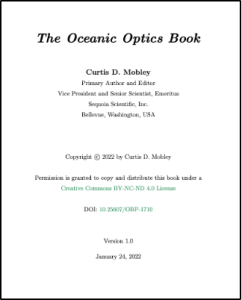 The Ocean Optics Web Book is a widely used resource for information on optical oceanography and ocean colour remote sensing. However, after a decade of use, the underlying software, which converts LaTeX code to web pages, was no longer supported. During 2019-2020 Dr. Curtis Mobely worked with a website company to revise the content-management software. Porting the Web Book content from its original host and software to the new platform gave him the opportunity to review and update the content, bringing uniformity of notation to web pages and adding many new web pages.
The Ocean Optics Web Book is a widely used resource for information on optical oceanography and ocean colour remote sensing. However, after a decade of use, the underlying software, which converts LaTeX code to web pages, was no longer supported. During 2019-2020 Dr. Curtis Mobely worked with a website company to revise the content-management software. Porting the Web Book content from its original host and software to the new platform gave him the opportunity to review and update the content, bringing uniformity of notation to web pages and adding many new web pages.
Many Web Book users have asked for a PDF version of the entire web site. Ask and ye shall receive! Dr. Mobley spent 2021 reformatting the web book content to a textbook layout, adding new material in the process. The result is The Oceanic Optics Book. This book has been published by the IOCCG to ensure that foundational knowledge is available to the ocean colour community, and can be downloaded from the IOCCG website free of charge.
The 16 chapters develop the standard material of optical oceanography and ocean colour remote sensing: radiometry, inherent and apparent optical properties, absorption, elastic and inelastic scattering, the optical properties of sea water constituents and of surfaces, radiative transfer and electromagnetic theory, remote sensing and the associated atmospheric correction, and visibility. The 7 appendices contain advanced and more mathematical topics: Fourier transforms and their use in modeling sea surfaces given a wave elevation variance spectrum or autocovariance function, Monte Carlo simulation as a way to compute radiances and irradiances, and the prediction of the appearance of an object as seen through water. Some of these appendices cover material that is outside the domain of optics, but he had to learn this material in order to carry out optical calculations such as the prediction of reflectance and transmission of light by wind-blown sea surfaces, and the prediction of underwater image degradation due to absorption and scattering. The existing literature never gave him enough detail to allow the writing of computer programs to implement the general theory. The appendices present the relevant theory and, in addition, give the many details needed for correct numerical calculations. We are unaware of any other publication that covers some of these details.
Dr. Mobley hopes that everyone will find something of use in the book. His suggestion is to read the table of contents to see what is there, and then to refer to specific sections as the need arises. He hopes The Oceanic Optics Book becomes the successor to his Light and Water text, which is now out of date. He welcomes your comments, corrections, and suggestions for additional topics (email: curtis.mobley@gmail.com)
News from NASA
Join the PACE Community of Practice (CoP)
 NASA’s Plankton, Aerosol, Cloud, ocean Ecosystem (PACE) mission is scheduled to launch in January 2024, and will extend and improve NASA’s 40+ year record of satellite observations of global ocean biology, aerosols, clouds, and land. Engagement of the broader community, including future PACE data end users, is integral to the success and sustainability of the mission.
NASA’s Plankton, Aerosol, Cloud, ocean Ecosystem (PACE) mission is scheduled to launch in January 2024, and will extend and improve NASA’s 40+ year record of satellite observations of global ocean biology, aerosols, clouds, and land. Engagement of the broader community, including future PACE data end users, is integral to the success and sustainability of the mission.
PACE invites members of the ocean color community to join the PACE Community of Practice (CoP), which includes PACE Early Adopters, who have committed to engage in pre-launch applied research to accelerate the integration of PACE products after launch in their specific application, and that aids decision-making and directly benefits society.
The overall goal of the PACE CoP is to provide individuals and groups with the unique opportunity to network and share information on the use of PACE data in pre-launch research. Through networking and information sharing, the CoP will seek to foster new partnerships and collaboration, generate new knowledge and innovations, and promote interdisciplinary research using PACE data.
View the full announcement here, and join the PACE CoP by completing this webform.
Virtual Community Meeting on pre-Arctic-COLORS Data Synthesis – Recordings Online
 You can now view talk recordings from the open Community Meeting, a pre-Arctic-COLORS (Arctic-COastal Land Ocean inteRactions) data synthesis activity, sponsored by NASA and the OCB Project Office. This synthesis activity is an important stepping-stone toward the development of the Arctic-COLORS Implementation Plan and eventually the Arctic-COLORS field campaign itself. The science group is collecting data and modeling resources to inform this synthesis. Visit the workshop website for more information and to view meeting recordings and information. Read more about the NASA Arctic-COLORS field campaign.
You can now view talk recordings from the open Community Meeting, a pre-Arctic-COLORS (Arctic-COastal Land Ocean inteRactions) data synthesis activity, sponsored by NASA and the OCB Project Office. This synthesis activity is an important stepping-stone toward the development of the Arctic-COLORS Implementation Plan and eventually the Arctic-COLORS field campaign itself. The science group is collecting data and modeling resources to inform this synthesis. Visit the workshop website for more information and to view meeting recordings and information. Read more about the NASA Arctic-COLORS field campaign.
News from NOAA
NOAA CoastWatch Meeting
 The NOAA CoastWatch Annual Science Meeting will be held May 9-13, 2022. It is planned as an in-person meeting at the NOAA Center for Weather and Climate Prediction in College Park, Maryland, USA, with potential to shift to a virtual meeting should COVID pandemic conditions warrant this change. NOAA CoastWatch also has a new brochure!
The NOAA CoastWatch Annual Science Meeting will be held May 9-13, 2022. It is planned as an in-person meeting at the NOAA Center for Weather and Climate Prediction in College Park, Maryland, USA, with potential to shift to a virtual meeting should COVID pandemic conditions warrant this change. NOAA CoastWatch also has a new brochure!
GEO Blue Planet
Some recent activities of the GEO Blue Planet Secretariat, hosted by NOAA include:
- Eutrophication Working Group – The working group is supporting a publication on a satellite-derived regional chlorophyll a indicator for Europe and is working on a publication for the global chlorophyll-a SDG indicator.
- Coastal Flooding Working Group – The WaveForce team produced a demo using historical data and are working to further develop the tool and secure resources.
- Sargassum Working Group – The Sargassum Hub is in the process of being updated to be more user friendly and to better answer users’ needs. The Hub will be translated into French when the technical updates are finalized.
- Fisheries Working Group – The fisheries working group will be identifying projects to pursue that are aligned with the newly revised core actions.
GeoXO – NOAA Pathfinder Initiative Kickoff Rescheduled
Due to the ongoing COVID-19 emergency, the Kennedy Space Center is limiting in-person events. As a result, the NOAA Pathfinder Initiative Town Hall formerly scheduled for February 28 in Cape Canaveral will now be entirely virtual and rescheduled to a later date in April. For more information, contact NOAAPathfindersTeam@cadmusgroup.com. Be sure to tell them of your connection to the IOCCG.
NOAA activities at Ocean Sciences Meeting
- NOAA CoastWatch tutorial on March 2, 2022 at 9-10a EST entitled TT04 Connecting Users to fit-for-purpose Ocean Satellite Data for Applications, Information and Decisions: NOAA Coastwatch/Oceanwatch/Polarwatch.
- NOAA CoastWatch Town Hall on February 24, 2022 at 12-1p EST entitled TH31 NOAA Ocean and Aquatic Satellite Data Products for Science and Applications.
- OT14 Innovative Applications of Operational and Emerging Ocean Satellite Observations on March 4, 2022 at 11:30a and 12:30p. The three companion poster sessions are entitled: OTP02 Ocean Technologies and Observatories Posters 1 (OT02+OT08+OT10+OT11+OT14+CB04+CB15) and are convening on March 2, 2022 at 7pm and 9pm.
Recent peer reviewed publications from the NOAA Ocean Color Science Team
Shi, W. and M. Wang, “Phytoplankton biomass dynamics in the Arabian Sea from VIIRS observations”, J. Mar. Syst., 227, 103670 (2022). doi:10.1016/j.jmarsys.2021.103670
Yu, X., Z. Lee, S. Shang, M. Wang, and L. Jiang, “Estimating water-leaving albedo from ocean color”, Remote Sens. Environ., 269, 112807 (2022). doi:10.1016/j.rse.2021.112807
Shi, W. and M. Wang, “Water optical property of high-altitude lakes in the Tibetan Plateau”, IEEE Trans. Geosci. Remote Sens., 60, 4201213 (2022). doi:10.1109/tgrs.2021.3065637
Shi, W. and M. Wang, “Tropical instability wave modulation of chlorophyll-a in the Equatorial Pacific”, Sci. Rep., 11, 22517 (2021). doi:10.1038/s41598-021-01880-5
EUMETSAT and NOAA OSOS2 Summary Workshop Report
The Second International Operational Satellite Oceanography Symposium (OSOS2) Summary Workshop Report is expected to be published in February 2022, which recaps the successful EUMETSAT-NOAA co-sponsored virtual meeting held in May 2021. Once published, this report will be shared publicly on the meeting website.
Journal Special Issues still open
Aquatic Carbon Stocks and Fluxes
The manuscript submission deadline for a special edition on Aquatic Carbon Stocks and Fluxes: The Big Picture from Remote Sensing in Earth-Science Reviews has been extended to May 1, 2022, with anticipated publication for Dec 2022. This special edition will highlight contributions that synthesize our current understanding of carbon stocks and fluxes in aquatic systems, and directions for future advancements. A particular focus will be on globally relevant topics that rely on the use of remote sensing data, including integration with in-situ measurements and models.
Reliable Detection of Water Quality and Aquatic Ecosystem Dynamics in Inland Waters
The call for papers for a Special Issue on Reliable Detection of Water Quality and Aquatic Ecosystem Dynamics in Inland Waters (Remote Sensing, section: Environmental Remote Sensing) is still open. The Special Issue focuses on remote sensing approaches dedicated to freshwater ecosystems and inland water quality. The submission deadline is 31 May 2022.
Upcoming Events
Training Courses
- EUMETSAT Online Short Courses on data discovery for weather, oceanography, air quality and climate. Many of these courses are relevant to the ocean colour community.
- Recordings for the on-line workshop on Remote Sensing for Ocean-Atmosphere Interaction Studies and Applications, now accessible online! (The workshop was held 1-3 December 2021).
- February 11-28, March 2022: International training on Monitoring Microbial Quality of Water, Kochi, Kerala, India
Ocean Carbon From Space Workshop
Ocean Carbon From Space Workshop hosted by the European Space Agency will take place completely online during February 14-18, 2022. The workshop will unite remote sensing scientists, field scientists and modellers around the topic of ocean carbon pools and fluxes and its variability in space and time to understand processes and interactions within the Earth system.
2022 Ocean Sciences Meeting
OSM 2022 starts this month, from 27 February to 4 March, 2022 with virtual sessions. Look out for the following sessions, relevant to the ocean colour community:
- CB04 PACE, GLIMR and SBG: Synergy across Future NASA Missions for Hyperspectral Remote Sensing of Coastal and Inland Waters
- CB05 Advancing Water Quality Monitoring and Forecasting in Coastal and Inland Waters
- CB15 Application of Remote Sensing to Societally Important Regions: Coastal, Estuarine, Tropical and Polar Waters
- CT07 Multidisciplinary insights into pathways of carbon export
- OB07 Research Opportunities from a Global Biogeochemical Argo Fleet
- OB27 Expanding Frontiers In Productivity and Flux from Ocean Optics
- OS11 Observing and Predicting the Global Coastal Ocean
- OT02 Ushering in a new era of hyperspectral and polarimetric radiometry for remote sensing of global ocean ecosystems
- OT08 Emerging Technologies and Techniques for Remote Sensing of Coastal and Inland Waters
- OT11 Lidar technology for the estimation of the surface and vertical ocean physical, optical, and biogeochemical properties
ESA Living Planet Symposium 2022
The ESA Living Planet Symposium (23-27 May 2022) will focus on how Earth observation contributes to science and society, and how disruptive technologies and actors are changing the traditional Earth observation landscape, which is also creating new opportunities for public and private sector interactions. Deadlines: abstracts 26 November 2021, registration 30 April 2022.
New Publications
Lin et al. (2021) published a new paper on better interpretation of harmful algal bloom (HAB) risk by combining Lagrangian trajectories and satellite observations. The algorithm can predict variations in chlorophyll-a concentration as well as changes in spectral properties of the water, which are important for discrimination of different algal species from satellite ocean color. The prediction scheme was applied to regions along the coast of England to verify its applicability. The authors show that the Lagrangian methodology can significantly improve the coverage of satellite products, and the unique animations are effective for interpretation of the development of HABs. A comparison between chlorophyll-a predictions and satellite observations further demonstrated the effectiveness of this approach: r2 of 0.81 and low mean absolute percentage error of 36.9%. Although uncertainties from modeling and the methodology affect the accuracy of predictions, the approach offers a powerful tool for monitoring the marine ecosystem and for supporting the aquaculture industry with improved early warning of potential HABs.
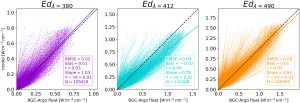
Match-up Ed(λ) with the final modeling configuration including all IOPs in the first 150 m, displaying the root mean square error (RMSE), bias, Pearson correlation coefficient (r), slope, intercept (Y-int), and number of points (N) for each of the three wavelengths considered.
Terzić et al. (2021) parameterized and validated a radiative transfer model using Biogeochemical Argo float data acquired between 2012 and 2017 across the Mediterranean Sea. Fluorescence-derived chlorophyll a concentration, particulate optical backscattering at 700 nm, and fluorescence of chromophoric dissolved organic matter (CDOM) were used to parametrize the light absorption and scattering coefficients of the optically significant water constituents (such as pure water, non-algal particles, CDOM, and phytoplankton). The model was validated with in situ downwelling irradiance profiles and apparent optical properties derived both from irradiance profiles and satellite data, such as the diffuse attenuation coefficients and remote sensing reflectance. Results showed that by using regional parameterizations that are not only related to chlorophyll concentration and vertical distribution, the model was able to capture a more accurate spectral response in the examined wavelength range compared to chlorophyll-related (or Case 1) optical models. When using alternative models that also incorporated measurements of CDOM fluorescence or particulate optical backscattering, the model skill increased at all examined wavelengths. Finally, using a multi-spectral optical configuration also enabled the estimation of the relative contribution of separate water constituents in the examined spectral range. Simulations including non-algal particles and CDOM performed up to 61% and 79% better than when considering the optical properties of pure seawater alone. Moreover, a simulation including phytoplankton light absorption resulted in an error reduction of up to 42%, especially at 412 nm and with a more uniform response at the wavelengths considered.
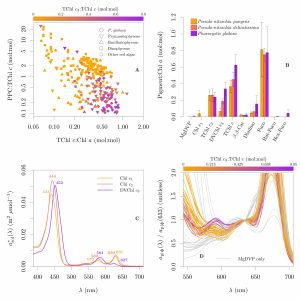
Pigmentation patterns and optical signatures: (A) Relation between Chl c3 fraction, TChl c:TChl and PPC:TChl c. (B) Pigment to Chl a ratio (mol:mol) in Pseudo-nitzschia pungens, Pseudo-nitzschia delicatissima and the North Sea variety of Phaeocystis globosa over multiple irradiances. (C) In solution spectral absorption coefficient per µmol of the three most common and abundant Chl c types. (D) Relative ap|φ observed in pure cultures.
In another new publication, Castagna et al. (2021) examined the optical signal of Phaeocystis globosa. In the North Sea, blooms of P. globosa are synchronous with those of the diatom Pseudo-nitzschia delicatissima, another harmful bloom-forming species with similar pigmentation and optical signature. The authors combined new and published measurements of pigmentation patterns and inherent optical properties from pure cultures of several algal and cyanobacterial groups, together with paired environmental spectroscopy and phytoplankton assemblage composition data, to: (1) Identify the pigment patterns generating the optical signals captured by two established hyperspectral algorithms for detection of P. globosa; (2) evaluate regionally the specificity and association of the pigments and optical signals with P. globosa; and (3) develop spectroscopy methods to retrieve pigment composition information that can be regionally associated with harmful algal blooms. The research revealed relevant pigment and optical ambiguities, arising primarily due to a broad pigmentation pattern across unrelated taxonomic groups and associated with the presence and relative abundance of chlorophyll c3 (Chl c3). As a consequence, the interpretations of the pigments generating the optical signals captured by the established algorithms were shown to be incorrect or incomplete and shown not to be specific to P. globosa, even in the context of the phytoplankton assemblage of the southern North Sea. Observed spatial and temporal associations between species with shared pigmentation patterns also hamper more specific interpretation of the optical signals related to those algorithms. The authors therefore provide absorption- and reflectance-based algorithms to retrieve relevant pigment composition information, the Chl c3 fraction (Chl c3:Total Chl c), which in the southern North Sea can be used to interpret the occurrence of harmful algal blooms. The study also provides in-depth discussion and recommendations on signal interpretation, algorithm development and communication.
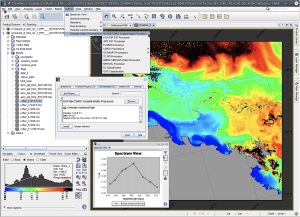
Ensemble ANN atmospheric correction algorithm running under SNAP (version 8) showing remote sensing reflectance at 412.5 nm for an optically complex Sentinel-3A OLCI FR test image.
Schroeder et al. (2022) have developed a new coastal atmospheric correction algorithm for Sentinel-3 OLCI that provides pixel-based estimation of the inherent model inversion uncertainty and sensor noise propagation. The algorithm is a full-spectral model-based inversion of radiative transfer simulations (RT) in a coupled atmosphere-ocean system. It uses an ensemble of artificial neural networks (ANN) that were initialized differently during the training process, but composed of the same network architecture. The algorithm has been validated against in-situ radiometric observations across a wide range of optical water types, and has been compared with the latest EUMETSAT operational Level 2 processor IPF-OL-2 v7.01. In this analysis the authors found that the ensemble ANN showed improved performance over the operational Level 2 processor with a band-averaged (412-708 nm) mean absolute percentage error of 16% compared to 37% and a four-times lower band-averaged bias of -0.00045 sr-1.
In the ensemble inversion process they account for three uncertainty components: (1) the total model variance that describes the variance of the data from the different ANNs, (2) the prediction variance of the mean, which is based on calculations of the RT simulations and (3) the instrument noise variance of the mean by propagating the OLCI spectral signal-to-noise ratios. To study algorithm performance and to quantify the contribution of the different uncertainty components to the total uncertainty, the authors applied the algorithm to an optically complex full resolution (FR) test scene covering coastal waters of the Great Barrier Reef, Australia. The uncertainties associated with the instrument noise variance were found to be two orders of magnitude lower than the uncertainty components of the prediction and total model variances. The overall largest uncertainty component in their uncertainty framework is attributed to the total model inversion error from averaging the responses of the slightly different adapted networks in the ensemble. The algorithm is made publicly available as a Python/C plugin for the Sentinel Application Platform (SNAP) and can be accessed at: https://github.com/s3tbx-fub-csiro/s3tbx-fub-csiro
Employment Opportunities
New positions are constantly being added to the IOCCG website. These include:
- Research Scientist, Greenbelt/Lanham, MD, USA, deadline Feb 20
- Internal Research Fellow in Future Mission Earth Science, ESA, ESTEC, Noordwijk, Netherlands, deadline Feb 14
- Internal Research Fellow in EO for Earth System Science, ESA, ESRIN, Frascati, Italy, deadline Feb 18
- Two Postdoctoral Research Associates and two PhD scholarships at Curtin University, Perth, Western Australia (applications open)
- Biological Oceanographer & Remote Sensing Scientist at ASL Environmental Sciences, Victoria, British Columbia, Canada
For more information on these and other positions see http://ioccg.org/resources/employment-opportunities/.
If you would like to include a position on this page, please contact Raisha Lovindeer.


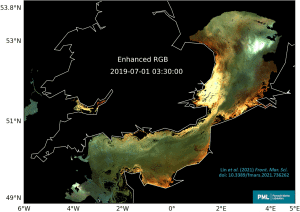

 The sixth International Ocean Colour Science (IOCS) meeting will take place in Darmstadt, Germany from 1 – 4 December 2025, hosted by EUMETSAT and ESA with support from other agencies.
The sixth International Ocean Colour Science (IOCS) meeting will take place in Darmstadt, Germany from 1 – 4 December 2025, hosted by EUMETSAT and ESA with support from other agencies.